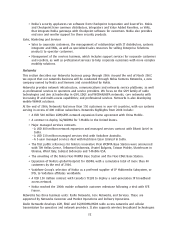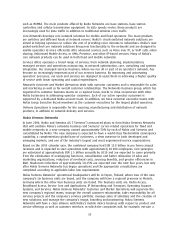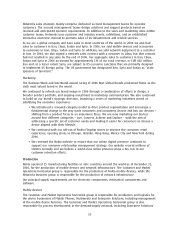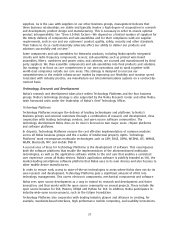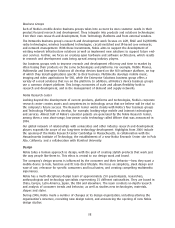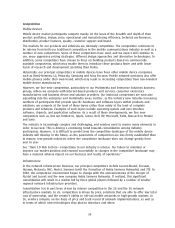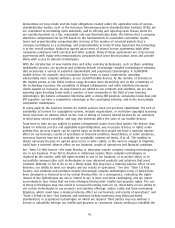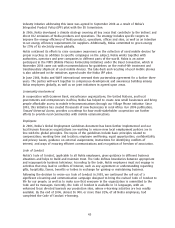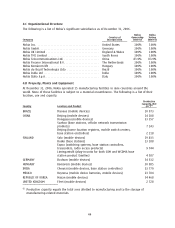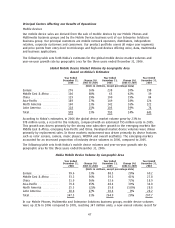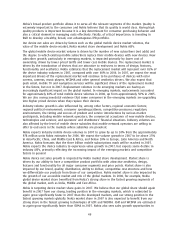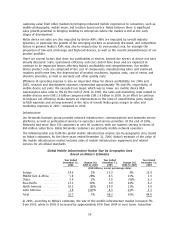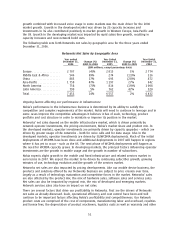Nokia 2006 Annual Report Download - page 43
Download and view the complete annual report
Please find page 43 of the 2006 Nokia annual report below. You can navigate through the pages in the report by either clicking on the pages listed below, or by using the keyword search tool below to find specific information within the annual report.invalidity of the intellectual property rights of these technologies. This may have a material adverse
effect on our results of operations.’’
Government Regulation
In the United States, our products and solutions are subject to a wide range of government
regulations that might have a direct impact on our business, including but not limited to regulation
related to product certification, spectrum management, network neutrality, competition, and
environment. For example, it is in our interest that the Federal Communications Commission
maintains a regulatory environment that ensures the continued growth of the wireless sector in the
United States. In addition, changes in regulation affecting the construction of base stations and
other network infrastructure could adversely affect the timing and costs of new network construction
or expansion and the commercial launch and ultimate commercial success of these networks. We are
in continuous dialogue with relevant United States agencies, regulators and the Congress through
our experts, industry associations and our office in Washington, D.C.
EU regulation has in many areas a direct effect on the business of Nokia and our customers within
the single market of the European Union. For example, in the telecommunications sector the EU has
adopted a set of rules that harmonizes the EU Member States’ regulatory framework for electronic
communication networks and services, and aims to encourage competition in the internal electronic
communications markets. Also, other regulatory measures have been taken in recent years in order
to address competitiveness, innovation, intellectual property rights, consumer protection and
environmental policy issues relating to the sector. We are in a continuous dialogue with the EU
institutions through our experts, industry associations and our office in Brussels.
Our business is subject to direct and indirect regulation in each of the countries in which we, the
companies with which we work or our customers do business. As a result, changes in various types
of regulations applicable to current or new technologies, products or services could affect our
business adversely. Moreover, the implementation of new technological or legal requirements, such
as the requirement in the United States that all handsets must be able to indicate their physical
location, could impact our products and solutions, manufacturing or distribution processes, and could
affect the timing of product and solution introductions, the cost of our production, products or
solutions as well as their commercial success. Finally, export control, tariffs or other fees or levies
imposed on our products, environmental, product safety and security and other regulations that
adversely affect the export, import, pricing or costs of our products and solutions, as well as new
services related to our products, could adversely affect our net sales and results of operations.
We are in a continuous dialogue with regulatory bodies through our experts, industry associations
and lobbyists.
Corporate Responsibility
During 2006, Nokia advanced its Corporate Responsibility efforts in response to feedback from our
various stakeholders. Highlights include:
Environmental activities
In 2006, Nokia’s environmental strategy continued to focus on three important areas: materials,
energy efficiency and product takeback.
In materials management, Nokia successfully completed its work on phasing out hazardous
substances as required by the European Union’s RoHS directive (Restriction of Certain Hazardous
Substances). Nokia had a fully RoHS compliant product offering in the EU well before the July 2006
phaseout deadline. Furthermore, Nokia aims that all its mobile devices will be EU RoHS compliant in
2007. In accordance with the precautionary principle, Nokia works on voluntary initiatives to find
safer alternatives for some materials of concern, for example brominated flame retardants. A joint
42


